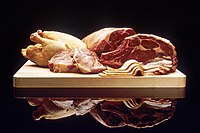
Photo from wikipedia
BackgroundAn experiment was conducted to evaluate the effects of feed restriction (FR) and sex on the quantitative and qualitative carcass traits of Morada Nova lambs. Thirty-five animals with an initial… Click to show full abstract
BackgroundAn experiment was conducted to evaluate the effects of feed restriction (FR) and sex on the quantitative and qualitative carcass traits of Morada Nova lambs. Thirty-five animals with an initial body weight of 14.5 ± 0.89 kg and age of 120 d were used in a completely randomized study with a 3 × 3 factorial scheme consisting of three sexes (11 entire males, 12 castrated males and 12 females) and three levels of feeding (ad libitum – AL and 30% and 60% FR).ResultsEntire males presented greater hot and cold carcass weights (P < 0.05), followed by castrated males and females. However, the hot carcass yield was higher for females and castrated males than for entire males. Luminosity values were influenced (P < 0.05) by sex, with entire males presenting higher values than castrated males and females. Females showed higher (P < 0.05) concentrations of linoleic acid and arachidonic acid in the meat of the longissimus thoracis muscle. The meat of animals submitted to AL intake and 30% FR showed similar (P > 0.05) concentrations, and the concentrations of palmitic acid, palmitoleic acid, stearic acid, oleic acid and conjugated linoleic acid were higher (P < 0.05) than those of animals with 60% FR. The meat of females had a higher ω6/ω3 ratio and lower h/H ratio, and females had greater levels of feeding. The meat of animals on the 60% FR diet had a greater ω6/ω3 ratio, lower h/H ratio and lower concentration of desirable fatty acids in addition to a greater atherogenicity index (AI) and thrombogenicity index (TI).ConclusionLambs of different sexes had carcasses with different quantitative traits without total influence on the chemical and physical meat characteristics. The lipid profile of the meat was less favorable to consumer health when the animals were female or submitted to 60% feed restriction.
Journal Title: Journal of Animal Science and Biotechnology
Year Published: 2017
Link to full text (if available)
Share on Social Media: Sign Up to like & get
recommendations!